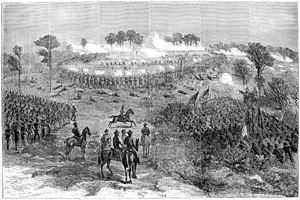Battle of Chaffin's Farm
| Battle of Chaffin's Farm and New Market Heights | |||||||
|---|---|---|---|---|---|---|---|
| Part of the American Civil War | |||||||
 Union assault on Fort Harrison, September 29 (after a sketch by William Waud) | |||||||
| |||||||
| Belligerents | |||||||
|
|
| ||||||
| Commanders and leaders | |||||||
|
Benjamin F. Butler |
Robert E. Lee Richard S. Ewell | ||||||
| Strength | |||||||
| 26,600[1] | 14,500[2] | ||||||
| Casualties and losses | |||||||
|
3,372 total 391 killed 2,317 wounded 649 missing/captured[3] |
2,000 total 250 killed 1,250 wounded 500 missing/captured[4] | ||||||
The Battle of Chaffin's Farm and New Market Heights, also known as Laurel Hill and combats at Forts Harrison, Johnson, and Gilmer, was fought in Virginia on September 29–30, 1864, as part of the siege of Petersburg in the American Civil War.
Background
From the very beginning of the war,
On July 27–29, the
In late September, Grant planned another dual offensive. Historians sometimes enumerate Grant's offensives during the Richmond–Petersburg Campaign. Richard J. Sommers, John Horn, and Noah Andre Trudeau call these operations "Grant's Fifth Offensive".
Butler devised a plan that historian John Horn called his "best performance of the war."
Orders of Battle
Union
Confederate
Battle

New Market Heights
Maj. Gen.
Once Birney's troops had taken New Market Heights, the X Corps turned to the north-west along the New Market Road and moved against a secondary line of works guarding Richmond north of Fort Harrison. Brig. Gen. Robert Sanford Foster's X Corps division assaulted a small salient known as Fort Gilmer. David Birney's brother, Brig. Gen. William Birney, led a brigade of U.S. Colored Troops against Fort Gregg south of Fort Gilmer. These attacks were marked by heroism among the Colored Troops but were ultimately repulsed.
Fort Harrison

At about the same time Birney's first attack moved forward, the Union XVIII Corps under Major General
Once inside the fort, the Union attackers became disorganized. All three of Stannard's brigade commanders were wounded or killed. A supporting column under Brig. Gen.
Robert E. Lee realized the severity of the loss of Fort Harrison and personally brought 10,000 reinforcements under Maj. Gen. Charles Field north from Petersburg. On September 30, Lee ordered a counter-attack to retake Fort Harrison, now commanded by Maj. Gen. Godfrey Weitzel, replacing the wounded Ord. The Confederate attacks were uncoordinated and were easily repulsed.
Aftermath
Just as Grant had anticipated, the fighting around Chaffin's Farm forced Lee to shift his resources and helped the Union army south of Petersburg win the
Medal of Honor recipients

The following men received the Medal of Honor for action in the battle:

- William H. Barnes
- Joseph H. Shea[11]
- Powhatan Beaty
- Thomas Belcher
- James H. Bronson
- George A. Buchanan
- Nathan Huntley Edgerton
- Christian Fleetwood
- James Daniel Gardner
- James H. Harris
- Thomas R. Hawkins
- Alfred B. Hilton
- Milton M. Holland
- William Stone Hubbell
- Miles James
- Franklin Johndro[12]
- Alexander Kelly
- Nathaniel A. McKown
- Robert A. Pinn
- Edward Ratcliff
- John Schiller
- Ebenezer Skellie
- Charles Veale
- William Laing
Three Medal of Honor recipients from the
Battlefield preservation
As of late 2021, the American Battlefield Trust and its partners have acquired and preserved 87 acres (0.35 km2) of the battlefield.[14]
See also
- Butler Medal, awarded to numerous participants
References
- Claxton, Melvin, "Uncommon Valor: The Story of Race, Patriotism and Glory in the Final Battles of the Civil War", 2005, ISBN 0-47146-8231
- Bonekemper, Edward H., III, A Victor, Not a Butcher: Ulysses S. Grant's Overlooked Military Genius, Regnery, 2004, ISBN 0-89526-062-X.
- ISBN 0-8094-4776-2.
- ISBN 0-684-84944-5.
- Horn, John, The Petersburg Campaign: June 1864 – April 1865, Combined Publishing, 1999, ISBN 978-1-58097-024-2.
- Kennedy, Frances H., ed., The Civil War Battlefield Guide, 2nd ed., Houghton Mifflin Co., 1998, ISBN 0-395-74012-6.
- Salmon, John S., The Official Virginia Civil War Battlefield Guide, Stackpole Books, 2001, ISBN 0-8117-2868-4.
- Sommers, Richard J., Richmond Redeemed: The Siege at Petersburg, Doubleday, 1981, ISBN 0-385-15626-X.
- Trudeau, Noah Andre, The Last Citadel: Petersburg, Virginia, June 1864 – April 1865, Louisiana State University Press, 1991, ISBN 0-8071-1861-3.
- National Park Service battle description
- CWSAC Report Update
- Richmond National Battlefield Park, Chaffin's Farm
- The Remarkable Life of a Quaker Civil War Hero
Notes
- ^ Sommers, p. 21.
- ^ Kennedy, p. 363. There were 4,500 defenders on September 29, reinforced by 10,000 on September 30.
- ^ Sommers, p. 499. Bonekemper, p. 317, cites 383 killed, 2,299 wounded, and 645 missing or captured. Trudeau, p. 217, cites 1,040 killed or missing and 2,317 wounded. Horn, p. 167, cites 3,327 total Union casualties. Salmon, p. 433, estimates 4,150 Union casualties.
- ^ Bonekemper, p. 317. Sommers, p. 499, cites 1,737 casualties, including 396 missing or captured. Horn, p. 167, Trudeau, p. 217, and Kennedy, p. 363, estimate 1,700 total Confederate casualties. Salmon, 433, estimates about 1,750 Confederate casualties, mostly on September 30.
- ^ Richmond National Battlefield description of Chaffin's Farm.
- ^ Salmon, pp. 398–99.
- Wilson-Kautz Raid, the First Battle of Deep Bottom and the Battle of the Crater, and the Second Battle of Deep Bottom and the Battle of Globe Tavern.
- ^ Salmon, p. 399.
- ^ Horn, p. 159.
- ^ Sommers, pp. 21–22; Kennedy, pp. 362, 364; Salmon, p. 429; Trudeau, p. 208; Horn, pp. 158–59.
- ^ "Medal of Honor Recipients".
- ^ Beyer, Walter Frederick (1901). Deeds of Valor. Perrien-Keydel Company. p. 440. Retrieved 1 September 2015.
franklin johndro deeds of valour.
- ^ Price, Jimmy (19 May 2013). "Freedom by the Sword: Don Troiani's New Market Heights Painting to be Unveiled June 24th".
- ^ "Saved Land". American Battlefield Trust. Retrieved November 24, 2021.
